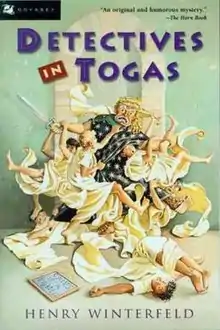Detectives in Togas
Detectives in Togas is a children's book written by Henry Winterfeld, and translated from the German by Richard and Clara Winston. It was published in 1956, and reissued in 1984, 1990, and 2003. Detectives in Togas was marketed for children ages 9–12.[1]
 Book cover (2003) | |
| Author | Henry Winterfeld |
|---|---|
| Original title | Caius ist ein Dummkopf |
| Translator | Richard and Clara Winston |
| Illustrator | Charlotte Kleinert |
| Country | United States |
| Language | English |
| Genre | Children's literature |
| Publisher | Harcourt Brace Jovanovich |
| Published | 1956 |
| Media type | |
| OCLC | 48846777 |
| Followed by | Mystery of the Roman Ransom |
Summary
Set in ancient Rome, the story follows a group of schoolboys who try to solve several crimes: the attack on their teacher and the desecration of a temple wall.
Reception
In the journal Elementary English, the reviewer calls it a "rousing detective story" and notes that Winterfeld was inspired by actual graffiti found during the excavation of Pompeii.[2] The journal The Classical World says Detectives in Togas is a "simple and lively story".[3] A reviewer in the library journal Collection Management says it "adds life to the study of ancient civilizations".[4]
The Christian Science Monitor says Detective in Togas "neatly succeeds in constructing a lesson in ancient history around the plot of a whodunit and spinning the whole thing into a great tale for middle school readers".[5] A reviewer in Huntingdon Daily News says the book has a "fascinating setting", and is "full of suspense and excitement".[6]
Kirkus Reviews describes it as "A good story and with its careful attention to Roman ways, this has its sparkle too"[7] and Publishers Weekly calls it "delightful and witty".[8] For the 2003 reissue, reviewer Terri Schmitz says it is "action-packed and filled with details about what daily life was like for patrician Roman boys, providing painless history lessons along with the rousing story lines."[9] The Guardian says readers "end up learning loads of interesting information about Ancient Rome as you go along - and even a bit of Latin!"[10]
References
- Cobb, Jane (3 Jun 1956). "Whodunits for Juniors". New York Times.
- Arbuthnot, May Hill; Clark, Margaret Mary (1956). "Books for Children". Elementary English. 33 (6): 389–399. ISSN 0013-5968. JSTOR 41384509.
- Ridington, Edith Farr (1967). "Some Recent Historical Fiction and Juveniles, XIII". The Classical World. 60 (9): 373. doi:10.2307/4346280. ISSN 0009-8418. JSTOR 4346280.
- Nancy Larson Bluemel MLIS (2004-10-12). "I Need a Good Mystery". Collection Management. 29 (3–4): 73–82. doi:10.1300/J105v29n03_06. ISSN 0146-2679.
- Kehe, Marjorie (19 Jun 2007). "Book Bits". The Christian Science Monitor.
- "Through These Doors". Huntingdon Daily News. 26 Dec 1972.
- "DETECTIVES IN TOGAS by Henry Winterfeld". Retrieved 13 Oct 2019.
- "Children's Book Review: Detectives in Togas". PublishersWeekly.com. Retrieved 2019-10-14.
- Schmitz, Terri (1 Jan 2003). "Sibling revelry. (Recommended Reissues)". The Horn Book Magazine. 79 (1).
- Pheebz (2013-02-04). "Detectives in Togas by Henry Winterfeld - review". The Guardian. ISSN 0261-3077. Retrieved 2019-10-14.